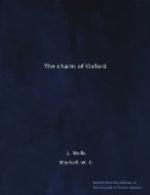yet it is for her towers, especially, that she is famous. Glorious as St. Mary’s is, it certainly does not surpass Magdalen Tower; and it may well be doubted whether the genius of Wren has not excelled both Magdalen and St. Mary’s in “Tom” Tower. Gothic purists, of course, do not like it. There is a well-authenticated story of a really great architect who, in the early days of the twentieth century, was asked to submit a scheme for its repair; after long delay he sent in a plan for an entirely new tower on correct Gothic lines, because (as he wrote) no one would wish to preserve “so anomalous a structure” as Tom Tower. The world, however, does not agree with the minute critics; it is easy to find fault with the details of “Tom,” but in proportion, in dignity, in suitability to his position, the greatest qualities that can be required in any building, “Tom” is pre-eminent. This is the more to be wondered at, as the tower was erected a century and a half after the great gateway which it crowns.
The genius of Wolsey had planned a magnificent front, but only a little more than half of it was completed when Henry VIII ended the career of his greatest servant, and altered the plans of the most glorious college in Europe. It was not till the period just before the Civil War that the northern part of the front of Christ Church was built by the elder Dean Fell, and the work was only completed when his son, the famous Dr. Fell, doomed to eternal notoriety by the well-known rhymes about his mysterious unpopularity, employed Wren to build the gate tower. Yet the whole presents one harmonious design, worthy of the most famous of Oxford founders and of the greatest of British architects. It is fitting that it should be Wolsey’s statue which adorns the gate—a statue given by stout old Jonathan Trelawny, one of the Seven Bishops, whose name is perpetuated by the refrain of Hawker’s spirited ballad, which deceived even Macaulay as to its authenticity:
“And must Trelawny die?
Then thirty thousand
Cornish men
Will know the reason
why.”
Tom Tower appeals to Oxford men through more than one of their senses; it is a most conspicuous object in every view; and in it is hung the famous bell, “Great Tom,” the fourth largest bell in England, weighing over seven tons. This once belonged to Osney Abbey, when it was dedicated to St. Thomas of Canterbury, and bore the legend:
“In Thomae laude resono Bim Bom sine fraude.”
It was transplanted to Christ Church in the reign of Queen Mary, and at the time it was proposed to rechristen it “Pulcra Maria,” in honour at once of the Queen and of the Blessed Virgin; but the old name prevailed. Every night but one, from May 29, 1684, until the Great War silenced him, Tom has sounded out, after 9 p.m., his 101 strokes, as a signal that all should be within their college walls; the number is the number of the members of the foundation of Christ Church in 1684, when the tower was finished. During the war Tom was forbidden to sound, along with all other Oxford bells and clocks, for might not his mighty voice have guided some zeppelin or German aeroplane to pour down destruction on Oxford? Few things brought home more to Oxford the meaning of the Armistice than hearing Tom once more on the night of November 11, 1918.




